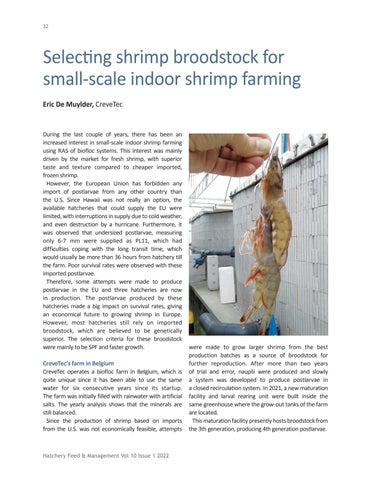32
Selecting shrimp broodstock for small-scale indoor shrimp farming Eric De Muylder, CreveTec
During the last couple of years, there has been an increased interest in small-scale indoor shrimp farming using RAS of biofloc systems. This interest was mainly driven by the market for fresh shrimp, with superior taste and texture compared to cheaper imported, frozen shrimp. However, the European Union has forbidden any import of postlarvae from any other country than the U.S. Since Hawaii was not really an option, the available hatcheries that could supply the EU were limited, with interruptions in supply due to cold weather, and even destruction by a hurricane. Furthermore, it was observed that undersized postlarvae, measuring only 6-7 mm were supplied as PL11, which had difficulties coping with the long transit time, which would usually be more than 36 hours from hatchery till the farm. Poor survival rates were observed with these imported postlarvae. Therefore, some attempts were made to produce postlarvae in the EU and three hatcheries are now in production. The postlarvae produced by these hatcheries made a big impact on survival rates, giving an economical future to growing shrimp in Europe. However, most hatcheries still rely on imported broodstock, which are believed to be genetically superior. The selection criteria for these broodstock were mainly to be SPF and faster growth.
CreveTec’s farm in Belgium CreveTec operates a biofloc farm in Belgium, which is quite unique since it has been able to use the same water for six consecutive years since its startup. The farm was initially filled with rainwater with artificial salts. The yearly analysis shows that the minerals are still balanced. Since the production of shrimp based on imports from the U.S. was not economically feasible, attempts
Hatchery Feed & Management Vol 10 Issue 1 2022
were made to grow larger shrimp from the best production batches as a source of broodstock for further reproduction. After more than two years of trial and error, nauplii were produced and slowly a system was developed to produce postlarvae in a closed recirculation system. In 2021, a new maturation facility and larval rearing unit were built inside the same greenhouse where the grow-out tanks of the farm are located. This maturation facility presently hosts broodstock from the 3th generation, producing 4th generation postlarvae.










